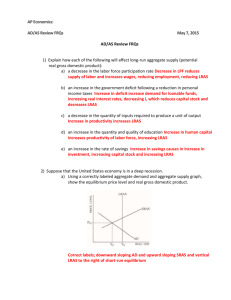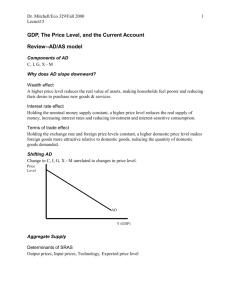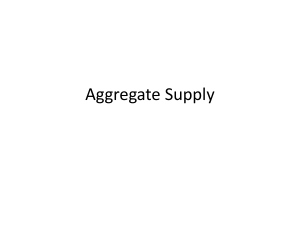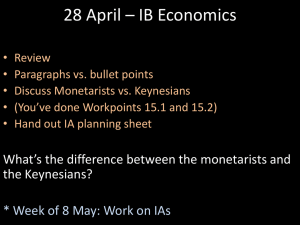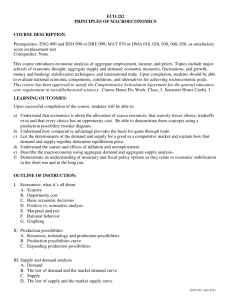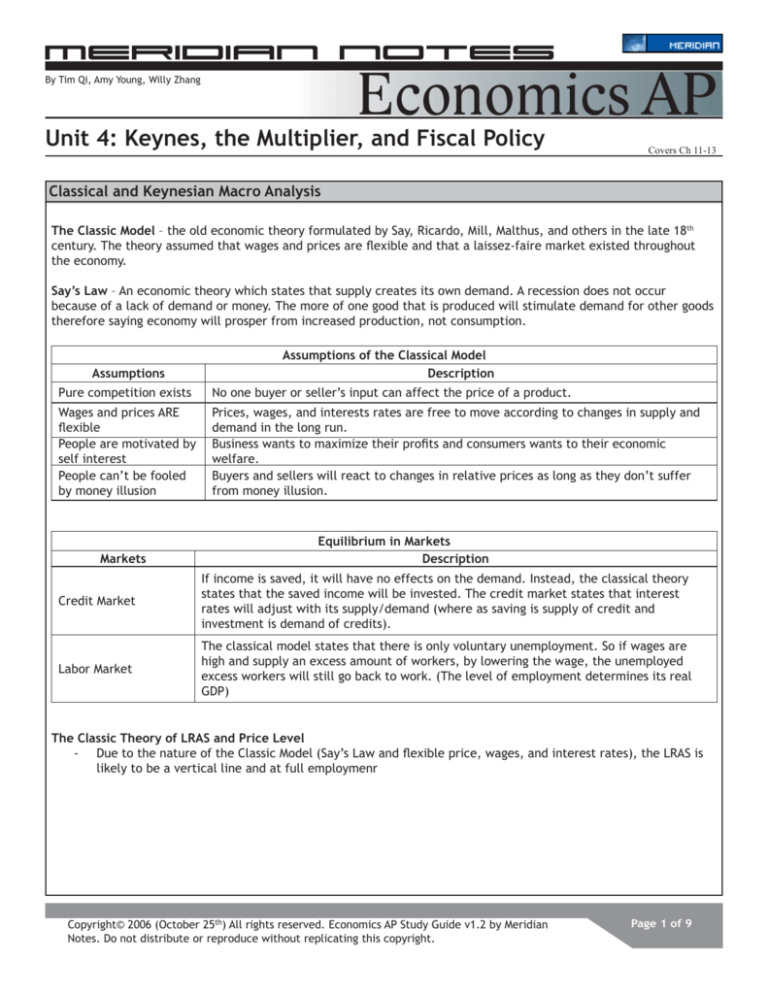
Meridian Notes
Economics AP
By Tim Qi, Amy Young, Willy Zhang
Unit 4: Keynes, the Multiplier, and Fiscal Policy
Covers Ch 11-13
Classical and Keynesian Macro Analysis
The Classic Model – the old economic theory formulated by Say, Ricardo, Mill, Malthus, and others in the late 18th
century. The theory assumed that wages and prices are flexible and that a laissez-faire market existed throughout
the economy.
Say’s Law – An economic theory which states that supply creates its own demand. A recession does not occur
because of a lack of demand or money. The more of one good that is produced will stimulate demand for other goods
therefore saying economy will prosper from increased production, not consumption.
Assumptions
Assumptions of the Classical Model
Description
Pure competition exists
No one buyer or seller’s input can affect the price of a product.
Wages and prices ARE
flexible
People are motivated by
self interest
People can’t be fooled
by money illusion
Prices, wages, and interests rates are free to move according to changes in supply and
demand in the long run.
Business wants to maximize their profits and consumers wants to their economic
welfare.
Buyers and sellers will react to changes in relative prices as long as they don’t suffer
from money illusion.
Markets
Equilibrium in Markets
Description
Credit Market
If income is saved, it will have no effects on the demand. Instead, the classical theory
states that the saved income will be invested. The credit market states that interest
rates will adjust with its supply/demand (where as saving is supply of credit and
investment is demand of credits).
Labor Market
The classical model states that there is only voluntary unemployment. So if wages are
high and supply an excess amount of workers, by lowering the wage, the unemployed
excess workers will still go back to work. (The level of employment determines its real
GDP)
The Classic Theory of LRAS and Price Level
- Due to the nature of the Classic Model (Say’s Law and flexible price, wages, and interest rates), the LRAS is
likely to be a vertical line and at full employmenr
Copyright© 2006 (October 25th) All rights reserved. Economics AP Study Guide v1.2 by Meridian
Notes. Do not distribute or reproduce without replicating this copyright.
Page 1 of 9
Effects of Changing AD in Classical Model
Keynesian Model
Keynesian Economics and the Keynesian SRAS
- The Keynesian Economic Model asserted the importance of aggregate demand for goods as the driving factor
of the economy, especially in periods of recessions.
Keynesian SRAS – Many prices in the economy such as wages are “sticky”. The “stickiness” creates involuntary
unemployment in labor. (The horizontal part of the SRAS is where there is unemployment and unused capacity in
economy).
Keynesian (with sticky SRAS)
Copyright© 2006 (October 25th) All rights reserved. Economics AP Study Guide v1.2 by Meridian
Notes. Do not distribute or reproduce without replicating this copyright.
Page 2 of 9
Keynesian Model (Cont.)
Income Determination Using AD and AS: Fixed VS Changing Price Levels in Short Run
-
Since the SRAS is horizontal, The Real GDP is completely determined by the AD. When the SRAS slopes upward
and the AD increases, the real GDP will increase by less because the increase in AD causes a slower increase
in nominal GDP as a result of increasing price levels as well.
Reasons for sloping SRAS
- Flexibility of hours and work.
- Existing capital can be used more intensively.
- Profits rise if prices go up by wages rates do not.
Shifts in both SRAS and LRAS
- Any changes in factors of production.
- Any changes in technology
Shifts in SRAS only
-
Temporary changes in input price
Determinants of Aggregate Supply
Increase
-
Decrease
Discoveries of new raw materials
Increased competition
A reduction in international trade barriers
Fewer regulatory impediments to business
An increase in labor supplied
Increased training and education
A decrease in marginal tax rates
A reduction in input prices
Case
-
Depletion of raw materials
Decreased competition
An increase in international trade barriers
More regulatory impediments to business
A decrease in labor supplied
Decreased training and education
An increase in marginal tax rates
An increase in input prices
Consequences of Changes in AD
Description
Aggregate Demand Shock
Any shock that causes the aggregate demand curve to shift inward or outward.
Aggregate Supply Shock
Any shock that causes the aggregate supply curve to shift inward or outward.
Copyright© 2006 (October 25th) All rights reserved. Economics AP Study Guide v1.2 by Meridian
Notes. Do not distribute or reproduce without replicating this copyright.
Page 3 of 9
AD shifts while SRAS is stable
A decrease in AD will decrease both the price level
and real GDP. If the real GDP is less than the LRAS, the
difference between the two is called the recessionary
gap.
An increase in AD will increase both the price level and
real GDP. If the real GDP is more than the LRAS, the
difference between the two is called the inflationary
gap (or expansionary gap).
Demand-pull Inflation due to the increase in aggregate demand not met with an ininflation
crease in aggregate supply, thus shifting off equilibrium.
Cost-push
inflation
Inflation caused by a decreasing SRAS curve. (i.e. The constantly increasing gasoline price)
Copyright© 2006 (October 25th) All rights reserved. Economics AP Study Guide v1.2 by Meridian
Notes. Do not distribute or reproduce without replicating this copyright.
Page 4 of 9
How a stronger dollar affects aggregate demand? – Reduces price of imports and increase the prices of exports.
The country’s imports will increase and exports will decrease shirting the AD left
The Net Effect
-
If SRAS shifts more than AD, price levels will fall
If AD shifts more than SRAS, price levels will rise
Comparison between Keynesian and Classical
Keynesian
–
–
–
Rigid prices
Short-run view
AD determines output
Classical
–
–
–
Flexible prices
Long-run view
LRAS determines output
Copyright© 2006 (October 25th) All rights reserved. Economics AP Study Guide v1.2 by Meridian
Notes. Do not distribute or reproduce without replicating this copyright.
Page 5 of 9
The Consumption Function (Cont)
Consumption and Saving
Consumption
Spending on new goods and services using household income. I.E.
Buying food, going to concert.
Consumption
goods
Savings
The goods being
consumed. I.E.
the food and concert.
The act of not consuming. Anything that is not consumed is
saved.
Consumption + Savings = Total
disposable income
Investment
The spending of a business to
produce more of or better their
product.
Capital Goods
Producer Durables. Non-consumable goods used by companies to
make other goods.
The Consumption Function
The Consumption Function – The relationship between Consumption and Disposable Income. A consumption function shows people’s planning of consumption at their current income.
Dissavings
According to the consumption function graph, dissaving occurs when
the current income falls below the
consumption line. It is when people
are forced to borrow or use up existing wealth.
Simplifying the Assumptions of Keynesian
Keynesian model needs a few assumptions. These are
the simplified assumptions.
Businesses pay no indirect taxes.
Businesses distribute profits to share holders
No depreciation (Gross domestic investment = net
investment)
Closed Economy (No world trade)
Diagram 12A: The orange (light gray) line represents
the consumption line. The black line (45-degree reference line) represents the different income levels.
Notice that before point A, the black line falls below
the orange line. That section between the two lines
before point A represents the dissavings. Point A is
sometimes called the breaking point.
45-Degree
Reference
Line
The black line represents income at
a given expenditure rate.
Autonomous This part of consumption has no relaConsumption tion to the income level.
Notice on the graph that consumption starts above zero. That would
be the autonomous consumption that
people need for survival.
Personal
income (PI)
Income households get before they
pay personal income taxes.
Personal income = National income +
transfer payments – income earned but
not received
Average Propensity
Average
propensity to
consume (APC)
Consumption divided by disposable income.
APC = consumption / real disposable income
Average proSavings divided by disposable
pensity to save income.
APS = savings / real disposable
(APS)
income
APC and APS gives the percentages of how much a
person/family/society/economy would save at a
given income.
Relation
Since not consumed is saved,
APC + APS = 1
Copyright© 2006 (October 25th) All rights reserved. Economics AP Study Guide v1.2 by Meridian
Notes. Do not distribute or reproduce without replicating this copyright.
Page 6 of 9
Marginal Propensity
Marginal
Propensity
to Consume
(MPC)
It is the ratio of change in consumption to the change in disposable
income.
MPC = Change in Consumption / Change
in disposable income
Marginal
Propensity to Save
(MPS)
It is the ratio of the change in savings
to the change in disposable income.
MPS = Change in Savings / Change in
disposable income
MPC and MPS are used to determine the change in
consumption and savings.
Likewise
MPS + MPC = 1
Wealth – A measure of all assets owned by a person,
family, firm, or nation.
Fiscal policy
Fiscal policy - Government’s choices regarding overall level of government purchases or taxes. Key to
Keynesian economic theory.
Government purchases directly shift the aggregate demand
curve, whereas changes to tax rates and money supply affect aggregate demand indirectly.
Contractionary vs. Expansionary fiscal policy
Contractionary fiscal policy is used when there is
an inflationary gap; the government takes in more
money and aggregate demand shifts left. Taxes go
up and/or government spending goes down. Both
price and real GDP decrease.
Expansionary fiscal policy is used when there is a
recessionary gap (during a recession); the government puts more money in circulation and aggregate
demand shifts right. Taxes are cut and/or government spending goes up. Both price and real GDP
increase.
Lump-sum tax – This tax does not depend on the
income or circumstances of the payer.
Long Run Aggregate Supply (LRAS) Fiscal Policy
The Multiplier
Multiplier – The ratio of the change in equilibrium
level of income to the change in autonomous expenditures. This multiplier is used to find the change
needed to restore back to equilibrium.
Simple Multiplier
Multiplier = 1 / (1-MPC) = 1 / MPS
Tax Multiplier
-MPC / MPS
The multiplier is used to determine how much money is
required to inject into the economy (usually by the government) to return National Income to equilibrium.
Example (Simple Algebra)
For example, if the simple multiplier is 4 and the NI is
12 million under equilibrium.
An increase in aggregate demand will establish a
temporary equilibrium at higher price and real GDP.
However, in the long run equilibrium will return
to a point on LRAS at original GDP but at a higher
price level than before. (Expansionary)
A decrease in aggregate demand will establish a
temporary equilibrium left of LRAS (more than 5%
unemployment) at a lower price level and real GDP.
However, in the long run equilibrium will return to
a point on LRAS at original GDP but at a lower price
level than before. (Contractionary)
Higher taxes reduce aggregate demand because it
1) reduces consumption
2) reduces investment
3) reduces net exports
When the current short-run equilibrium is greater
than LRAS (less than 5% unemployment), increasing
taxes shifts aggregate demand left to intersect with
LRAS at a lower price level. Real GDP and price level
fall.
Multiplier * Injected Money (G) = NI Deficit
4 * G = 12 million
Crowding-out effect - Reduction in demand that
results when fiscal expansion raises interest rates
G = 3 million
Therefore, 3 million dollars need to be injected
into the economy to bring the National Income (NI)
back to equilibrium according to this multiplier.
Copyright© 2006 (October 25th) All rights reserved. Economics AP Study Guide v1.2 by Meridian
Notes. Do not distribute or reproduce without replicating this copyright.
Page 7 of 9
Crowding Out Effect
Comprised of four parts.
Higher interest rates discourage consumption and
investment.
Government spending “crowds out” private spending.
Aggregate demand, while still higher than initial aggregate demand, actually shifts left and leaves the
desired equilibrium.
Thus, government spending intended to increase
aggregate demand actually isn’t completely effective since the crowding-out effect causes a
decrease in aggregate demand and dampens the
positive effect of expansionary policy.
Refer to Chart for some clarifications
Components of GDP / GDI
Fig 1. The crowding-out effect. Government expansionary policy does increase aggregate demand, but the crowdingout effect offsets the amount of increase.
New Classical Economics
Ricardian equivalence theorem - An increase in the government budget deficit (a.k.a. tax cuts, deficit spending,
etc.) has no effect on aggregate demand. This assumes people consider future government actions beyond this year.
Direct expenditure offsets - Actions on the part of private sector in spending money that offset government fiscal
policy actions. Increasing government spending in a field that competes with private sector will have some offset effect (direct crowding-out).
Extreme Case
Where direct expenditure offset is dollar for dollar; no change in total spending since government
spending increases by the same amount that it crowds out of consumption. Aggregate demand and
GDP remain the same.
Less Extreme
Case
Real output and price level will be affected, and predicted changes in aggregate demand will be
lessened.
Copyright© 2006 (October 25th) All rights reserved. Economics AP Study Guide v1.2 by Meridian
Notes. Do not distribute or reproduce without replicating this copyright.
Page 8 of 9
Fiscal Policies (Cont.)
Supply side
economics
Creating incentives for individuals
and firms to increase productivity will
cause the aggregate supply curve to
shift outward. If reductions in marginal tax rates induce enough additional work, saving, and investing,
government tax receipts can actually
increase.
Fiscal policy takes a long time to plan and implement
because of various lags. By the time the policy does
impact the economy, it may be irrelevant or even
harmful.
Time Lags
Recognition Time required to gather informatime lag
tion about the current state of the
economy.
Action time Time required between recognizing an
lag
economic problem and putting policy
into effect. Short for monetary policy
but long for fiscal policy. (Ex: approval
by Congress)
Effect time
lag
Time that elapses between the onset
of policy and the results of policy.
Automatic (built-in) stabilizers = Special provisions
of the tax law that cause changes in economy without
action of Congress and the president. (Ex: progressive
income taxes, unemployment compensation)
Tax systems
In a recession, tax collections fall
faster than disposable income. In an
expansion, tax collections rise faster
than disposable income.
Unemployment compensation
In a recession, unemployment
compensation and welfare payments
rise. In an expansion, unemployment
compensation and welfare payments
fall.
Discretionary (deliberate) fiscal policy such as tax
cuts and increased government spending help more in
abnormal times (wartime, severe depressions, etc.)
than in small recessions.
However, fiscal policy may have a “soothing effect”
that reassures consumers and investors and induces
stable expectations, since they know fiscal policy can
prevent severe depressions.
Copyright© 2006 (October 25th) All rights reserved. Economics AP Study Guide v1.2 by Meridian
Notes. Do not distribute or reproduce without replicating this copyright.
Page 9 of 9

